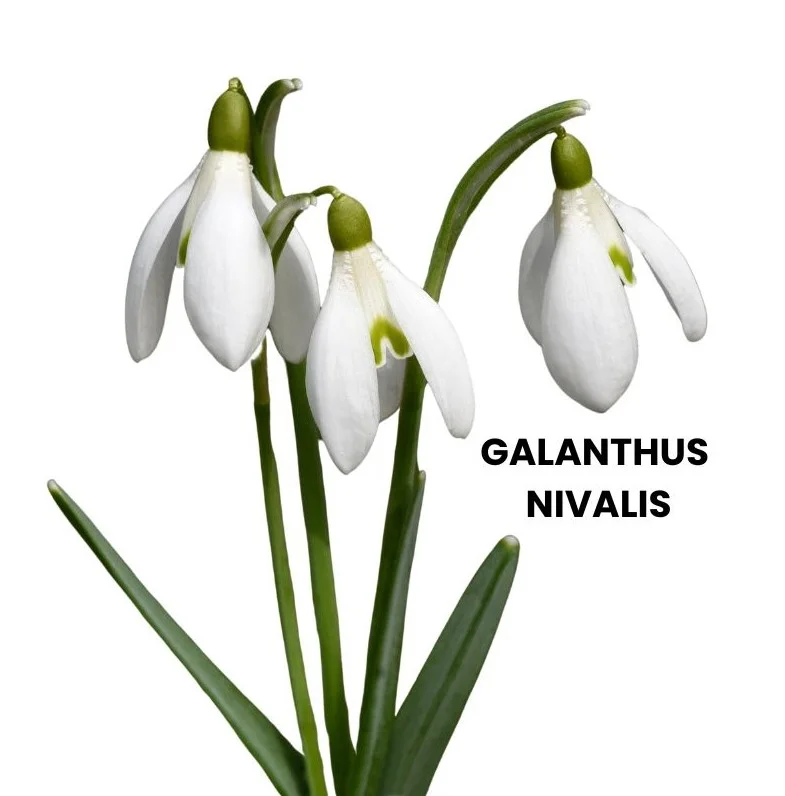Galanthus nivalis, commonly known as Snowdrop, is a small perennial bulbous plant native to Europe and parts of western Asia.
It is renowned for its delicate white flowers, which often emerge from the snow in late winter or early spring, symbolizing hope, and renewal.
In homoeopathic medicine, Galanthus nivalis is used as a remedy primarily for cardiovascular conditions, particularly those involving the heart valves.

Table of Contents
ToggleSOURCE INFORMATION
Scientific Classification
- Kingdom: Plantae
- Order: Asparagales
- Family: Amaryllidaceae
- Genus: Galanthus
- Species: Galanthus nivalis
Origin and Historical Facts
- Galanthus nivalis, commonly known as the snowdrop, is a perennial bulbous plant native to Europe and parts of western Asia.
- Historically, snowdrops have been admired for their delicate beauty and are often associated with the arrival of spring, as they are one of the first flowers to bloom at the end of winter.
- The name “Galanthus” is derived from Greek words “gala,” meaning milk, and “anthos,” meaning flower, referring to the pure white colour of the blossoms.
Homoeopathic Application
- Galanthus nivalis is utilized in homeopathy based on provings conducted by Dr. A. Whiting Vancouver.
- It is indicated for various cardiovascular symptoms, including weakness of the heart with sensations of collapse, rapid and irregular pulse with violent palpitations, and systolic murmurs at the apex.
- Additionally, it is used for respiratory symptoms such as sore, dry throat, and central nervous system symptoms like faintness, sinking sensations, dull headaches, and half-consciousness during sleep.
- Therapeutically, it has shown benefit in cases of mitral regurgitation with broken-down compensation and myocarditis with some degree of mitral insufficiency.
- The typical dosage ranges from the first potency to the fifth potency.
DRUG PATHOGENESIS
- Galanthus nivalis provings reveal symptoms of faintness, sinking sensations, sore dry throat, dull headache, and half-consciousness during sleep.
- It affects the heart, causing weakness, sensations of collapse, rapid and irregular pulse, violent palpitations, and systolic murmurs at the apex.
- Therapeutically, it is indicated for conditions such as Mitral Regurgitation with broken down compensation and Myocarditis with mitral insufficiency.
KEY CHARACTERISTICS
- Delicate white flowers emerging from snow, symbolizing hope, and renewal.
- Primarily used in homoeopathy for cardiovascular conditions, particularly those involving the heart valves.
- Symptoms include faintness, sinking sensations, sore dry throat, headache, and heart weakness with palpitations and irregular pulse.
DETAILED ORGAN SYMPTOMS
CARDIOVASCULAR SYSTEM
- Weakness of the heart with sensations of collapse: Patients experience a profound weakness in the heart, often accompanied by sensations of imminent collapse or fainting.
- Rapid, irregular pulse with violent palpitations: The heartbeat becomes rapid and irregular, accompanied by intense and forceful palpitations, which may be felt as pounding or fluttering sensations in the chest.
- Systolic murmurs at the apex: Abnormal heart sounds, known as systolic murmurs, are heard during the contraction phase of the heartbeat, particularly at the apex of the heart.
RESPIRATORY SYSTEM
- Sore, dry throat: Patients may experience discomfort and dryness in the throat, often accompanied by soreness or irritation.
CENTRAL NERVOUS SYSTEM
- Faintness, sinking sensations: Patients may feel dizzy or lightheaded, experiencing sensations of sinking or instability.
- Dull headache: Patients report a persistent, mild headache characterized by a dull, achy sensation in the head.
- Half-consciousness and worried feeling during sleep: During sleep, individuals may experience a state of partial consciousness, accompanied by feelings of worry or unease. They may not fully reach a deep, restful sleep state.
MODALITIES
- Symptoms worsen with physical exertion.
- Symptoms improve with rest and relaxation.
WHAT ARE MODALITIES IN HOMOEOPATHY?
RELATIONSHIP WITH OTHER DRUGS
- Galanthus nivalis may be used alongside other homoeopathic remedies for cardiovascular conditions, such as Crataegus oxyacantha and Digitalis purpurea.
- It complements conventional treatments for heart conditions, but medical supervision is necessary when using both approaches.
DOSE
- Galanthus nivalis is typically administered in potencies ranging from the first to the fifth.
- Dosage may vary based on individual case presentation and practitioner recommendation.
Frequently Asked Questions (FAQs)
What is Galanthus nivalis used for in homoeopathy?
- Galanthus nivalis is primarily used for cardiovascular conditions, particularly those involving the heart valves, such as Mitral Regurgitation and Myocarditis.
Are there any side effects of using Galanthus nivalis?
- Side effects are uncommon when used in homoeopathic potencies. However, as with any remedy, it is essential to consult with a qualified practitioner for proper dosage and supervision.
Can Galanthus nivalis be used alongside conventional treatments for heart conditions?
- Yes, it can complement conventional treatments, but medical supervision is recommended to ensure compatibility and monitor progress.
Meaning of Difficult Words
- Mitral Regurgitation: A condition where the heart’s mitral valve does not close properly, causing blood to flow backward into the heart.
- Myocarditis: Inflammation of the heart muscle.
- Systolic Murmur: Abnormal heart sounds heard during the contraction phase of the heartbeat.
- Potencies: Different dilutions or concentrations of a homoeopathic remedy used to treat various conditions.
